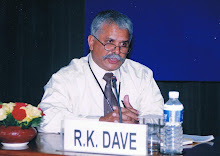
Managing Tsunami in India - By Dr R K Dave
Tsunamis consist of a series of very long waves generated by any rapid, large-scale disturbance of the sea. Most are generated by sea floor displacements from large undersea earthquakes. Tsunamis can cause great destruction and loss of lives within minutes on shores near the source, and some tsunamis can cause destruction within hours across an entire ocean basin.
Most tsunamis occur in the Pacific region but they are known to happen in every ocean and sea. Although infrequent, tsunamis are a significant natural hazard with great destructive potential. They can only be dealt with effectively through efficient detection, monitoring, measuring system cascaded with alert and warning, mitigation, and education.
Tsunamis consist of a series of very long waves generated by any rapid, large-scale disturbance of the sea. Most are generated by sea floor displacements from large undersea earthquakes. Tsunamis can cause great destruction and loss of lives within minutes on shores near the source, and some tsunamis can cause destruction within hours across an entire ocean basin.
Most tsunamis occur in the Pacific region but they are known to happen in every ocean and sea. Although infrequent, tsunamis are a significant natural hazard with great destructive potential. They can only be dealt with effectively through efficient detection, monitoring, measuring system cascaded with alert and warning, mitigation, and education.
Deep Ocean Assessment and Reporting of Tsunamis (DART) system is commonly used for monitoring and measuring Tsunamis. DART system consists of an anchored seafloor bottom pressure transducer and a companion moored surface buoy for real-time communications.
A powerful acoustic radio modem transmits data from the submerged platform to the surface buoy. The data are then relayed via Inmarsat-C satellite link to Land stations, which forward the signals for immediate dissemination to Warning Centers. There are 32 sensor buoys in the Pacific working round the clock. Each deep sea station is designed to detect and report tsunamis on its own, without instructions from land.
A powerful acoustic radio modem transmits data from the submerged platform to the surface buoy. The data are then relayed via Inmarsat-C satellite link to Land stations, which forward the signals for immediate dissemination to Warning Centers. There are 32 sensor buoys in the Pacific working round the clock. Each deep sea station is designed to detect and report tsunamis on its own, without instructions from land.
Monitoring deep ocean earthquakes using modern technology tsunameter and conveying it to Tsunami warning center is not enough. For saving lives and property – the Tsunami alert must reach to the people along with required support in identified risk zone as quickly as possible so as they can take shelter at high altitude locations.
National EOC, State EOC and District EOC play a crucial role in the in-land management of Tsunami warnings. National network of EOC(s) connected with remotely manageable national grid of coastal area alert and warning system is the only way for in-land management of such hazards. RESPECT(WWW.respect.org.in) has recently organized a National Conference on EOC & Disaster Response Operation.



No comments:
Post a Comment